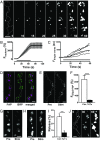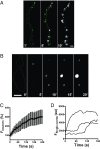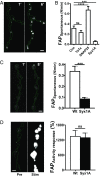Activity-evoked and spontaneous opening of synaptic fusion pores
- PMID: 31383765
- PMCID: PMC6708360
- DOI: 10.1073/pnas.1905322116
Activity-evoked and spontaneous opening of synaptic fusion pores
Abstract
Synaptic release of neuropeptides packaged in dense-core vesicles (DCVs) regulates synapses, circuits, and behaviors including feeding, sleeping, and pain perception. Here, synaptic DCV fusion pore openings are imaged without interference from cotransmitting small synaptic vesicles (SSVs) with the use of a fluorogen-activating protein (FAP). Activity-evoked kiss and run exocytosis opens synaptic DCV fusion pores away from active zones that readily conduct molecules larger than most native neuropeptides (i.e., molecular weight [MW] up to, at least, 4.5 kDa). Remarkably, these synaptic fusion pores also open spontaneously in the absence of stimulation and extracellular Ca2+ SNARE perturbations demonstrate different mechanisms for activity-evoked and spontaneous fusion pore openings with the latter sharing features of spontaneous small molecule transmitter release by active zone-associated SSVs. Fusion pore opening at resting synapses provides a mechanism for activity-independent peptidergic transmission.
Keywords: Drosophila; fusion pore; neuromuscular junction; neuropeptide release; secretory granule.
Conflict of interest statement
The authors declare no conflict of interest.
Figures





References
Publication types
MeSH terms
Substances
Grants and funding
LinkOut - more resources
Full Text Sources
Molecular Biology Databases
Miscellaneous

